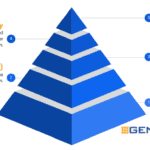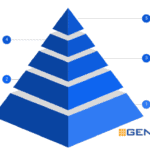Customers buy products because they solve one (or, ideally, more) of their biggest challenges. Your product’s success depends on how effectively it reflects, addresses, and solves those problems — referred to as customer pain points.
In today’s article, I’ll break down what a customer pain point is, what they look like on a granular level, and how you can go about identifying and addressing them.
What Is a Customer Pain Point?
A customer pain point is a persistent challenge your ideal customer faces. It’s often described as an area of friction, inconvenience, or disruption in their daily personal or professional life. You address customer pain points through your product, ancillary services, and customer experience.
Types Of Customer Pain Points
The four main types of customer pain points
- Physical — tangible problems, such as a lack of time or resources to effectively achieve a goal.
- Financial — financial loss or damage incurred from either using a different solution or not having one at all.
- Emotional — mental or emotional stress caused by the complexity or effort required to complete a task.
- Logistical — a lack of efficient processes or structure, such as an ineffective supply chain or a cumbersome process for onboarding customers.
These are the main reasons someone will buy your product. And you can apply them to B2B or B2C customers.
B2B vs. B2C customer pain points
A B2B customer pain point is a problem that impacts their business. Their primary goal is to increase their company’s productivity and profitability. So, any product that can help them achieve that will be a priority for them.
B2C customer pain points are more focused on convenience and quality of life. For example, a streaming service could address the physical pain point of having to drive to a theatre for entertainment, or it could address the emotional challenge of not having enough time to spend with family.
The best products address multiple pain points. For most customers, the abovementioned streaming service addresses:
- the convenience of not having to leave home
- the financial benefit of paying a lower monthly fee instead of buying tickets for every movie
- and the emotional reward of spending time with family more easily
How to Identify Customer Pain Points
The first step in fixing customer pain points is of course identifying them. Here are several effective methods to uncover these pain points:
Conduct Customer Surveys and Interviews
Direct feedback from customers is invaluable. Use a mix of quantitative and qualitative questions to gather comprehensive insights.
- Quantitative surveys: Use rating scales or multiple-choice questions to gauge overall satisfaction and pinpoint problem areas.
- Qualitative interviews: Conduct in-depth interviews to understand the nuances of customer experiences and uncover hidden pain points.
Pro tip: Ask open-ended questions like “What’s the biggest challenge you face when using our product?” to encourage detailed responses.
Analyse Customer Support Data
Your support tickets are a goldmine of information about customer pain points.
- Review common issues and complaints
- Look for patterns in ticket volume and resolution times
- Analyze customer sentiment in support interactions
Tools like AI-powered text analysis can help categorize and prioritize issues at scale.
Leverage Sales Team Insights
Your sales team interacts with prospects daily and can provide valuable insights.
- Conduct regular debriefs with sales reps
- Analyze lost deals to understand why prospects chose competitors
- Create a system for sales to log pain points they encounter
Implement User Testing and Usability Studies
Observe how customers interact with your product to identify friction points.
- Conduct usability tests with representative users
- Use heat mapping tools to see how users navigate your website or app
- Implement session recording to identify where users struggle
Monitor Social Media and Online Reviews
Customers often voice their frustrations on social platforms and review sites.
- Use social listening tools to track mentions of your brand
- Analyze reviews on platforms like G2, Capterra, or industry-specific review sites
- Pay attention to comparisons with competitors
Analyse Behavioural Data
Look at how customers actually use your product or service.
- Track key metrics like feature usage, time spent on tasks, and abandonment rates
- Identify bottlenecks or drop-off points in your user journey
- Use analytics tools to create funnels and track user paths
Conduct Competitor Analysis
Understanding your competitors can reveal pain points in your industry.
- Analyse competitor reviews to see what customers like or dislike
- Compare feature sets to identify gaps in your offering
- Monitor competitor messaging to see what pain points they’re addressing
Implement Customer Journey Mapping
Create a visual representation of the customer’s experience with your brand.
- Identify touchpoints where customers interact with your business
- Note emotions and pain points at each stage of the customer journey
- Use this map to find opportunities for improvement
Use AI and Machine Learning
Leverage AI, machine learning and advanced technology to analyse large volumes of customer data.
- Implement natural language processing to analyse open-ended feedback
- Use predictive analytics to anticipate future pain points
- Employ sentiment analysis to gauge customer emotions across touchpoints
7 common areas of customer pain (and how to address them)
Although there are four major categories of customer pain points (physical, emotional, financial, and logistical), looking at them throughout the customer journey makes more sense. Consider your product or service as an entire experience — how will customers interact with it before, during, and after purchase?
To fully grasp your customers and their potential challenges, look at these seven key areas:
Online research
Most B2C shopping experiences happen entirely online. In B2B — which has characteristically longer sales cycles — the customer is as much as 70% of the way through the purchase process before they talk to sales.
Although online research takes up the largest portion of the customer journey, it also has the easiest solution: brand visibility.
- Solve problems with your content. Offer a wealth of resources alongside your product — blog posts, videos, whitepapers, case studies — so customers can learn more about you. When you address smaller pain points before they buy, your customers will immediately see you as a viable solution.
- Make your most important content easy to find. Use a chatbot to route current and prospective customers to your FAQ, pricing, and comparison pages, highlight your product-led pillar content, and fix your site architecture to make these pages visible on a drop-down menu.
- Run ad campaigns that highlight solutions to pain points. You might not have $20k/month for ads. But you can get the word out on any budget. Focus on your core buyers first, and use different types of copywriting to highlight the financial and productivity challenges your customers may face.
- Optimize everything for search visibility. You need to ensure that you have well-optimized content and web pages because SEO is the first step in the conversion process for most brands. When someone Googles a question or product, you want to be the first answer they find.
This isn’t the stage where customers think super hard about a particular product, but it’s the most critical for you as a brand. The company that shows up first, answers questions, and adds value usually gets the sale.

For instance, many of our blogs perform well on search engines. From just one keyword (“advantages of a survey”), we get more than 50 visitors. Across all the keywords that article ranks for, it’s hundreds.

Through content marketing, we make it easy for potential customers to find the information they’re looking for. And we generate leads from our content.
Financial
Whether we like it or not, cash rules everything around us. We’re all in the business of making money, so financial pain points are the most common (and usually the most consequential) customer pain points out there.
A lot of companies seem to think having the best prices is the only way to compete. The reality is it’s all about value perception. To address financial pain points, your product needs to reflect the value your customers think they are getting in return for buying it.
- How long will your product last before it needs replacing? Some customers prefer to buy low-quality products for lower prices, even though they’re aware they’ll need to repurchase them. Others understand the value of long-term investments, so they’re willing to spend more for quality.
- Is it an ongoing expense? While some buyers prefer to pay monthly/annually to access a service, others are skeptical that a subscription or rental will cost more over time (because it usually does). The predictability of recurring revenue makes it more profitable and scalable, but you have to evaluate your product to ensure it makes sense.
- How often will customers make repeat purchases? Customers typically expect price breaks for products they buy in bulk. This is especially true for disposable items, which are usually more expensive than reusable ones (even in bulk). If your buyers care about convenience, they’ll opt for something disposable. If they can’t stand recurring costs, they’ll want something reusable.
- How much are they willing to spend for value? Some customers are happy to pay premium prices for premium quality. Others want the best value for their money. It’s well-known that luxury products rarely reflect quality (i.e., you obviously don’t need to spend $300 for the highest-quality t-shirt).
You may think customers on the high end have no financial pains. Or, you might assume budget-conscious customers are primarily concerned with price.
In both cases, you’d be wrong. To address financial problems, look beyond price. Instead, figure out what kind of value they’re looking for (quality, convenience, sustainability, etc.) and make sure your product can offer it. Then, communicate it through your sales team and marketing collateral.
Productivity
Productivity challenges boil down to one word: efficiency. Customers hate doing extra work, so they’ll shy away from anything they think is too time-consuming.
Think about ordering a cheeseburger at McDonald’s vs. ordering one at the swanky downtown bar vs. making one at home.
- McDonald’s is the fastest and most convenient option, but what goes into making it is… questionable. Buyers will choose it when they’re in a hurry or on a mission to get somewhere.
- The downtown bar option takes a bit more effort and might require a reservation, but the quality is much higher. Many restaurants offer unique takes on the German-American classic. It costs $20, though, so most would consider it more of an occasion.
- Cooking at home is rewarding, and you have the added benefit of controlling exactly what goes into it. However, it requires you to shop for ingredients, be at home, and be willing to spend time preparing the meal and cleaning up afterward.
People ordered burgers at restaurants and cooked them at home decades before fast food took off in the 1950s. Fast food filled the productivity gap in this case — thanks to McDonald’s, there’s a cost- and time-efficient way to enjoy the same great-tasting meal.
The same goes for your product: make it as efficient as possible so customers don’t have to waste time on needless tasks. Automate processes, offer a quick onboarding process, provide customer support materials in multiple formats (FAQs, tutorials, manuals), and create products and experiences that require less friction to set up and use.
Product cost
Product cost pain points involve the total cost of buying your product. Think of them as an extension of financial pain points — customers want to know what they’re buying and how much they’re paying for it.
Transparency is the goal here. When potential customers have a hard time figuring out the total cost of your product, they’ll find a competitor that offers more transparency.
Most companies use some form of differential pricing to make their product more accessible (e.g., a student discount for a software license). If you’re going to use tiered pricing, you have to be absolutely clear about what each tier includes. And, of course, avoid hidden fees at all costs.
When trying to solve customer pain points, preparing a competitive intelligence report can also help you create a superior product and pricing strategy.
Checkout/purchase
A difficult checkout process means lost sales 10/10 times. 77% of B2B buyers told Gartner their last purchase was difficult or complex.
Most customers will deal with a certain level of inefficiency. Some things they won’t tolerate.
For example:
- Complicated forms
- Slow loading times
- Unclear terms of service or pricing information
- Limited payment options
You want to avoid unnecessary friction. Pointless questions, approvals, and paperwork take up time and don’t add any value.
Fulfilment, tracking, and delivery
If you’re selling physical products, your customers will want to know when they can expect them. If they can’t, or you have a haphazard process for doing so, they’ll get frustrated.
When it comes to these logistical pain points, transparency is usually more important than delivery time (although you should optimize for that as well).
- On the confirmation page or email, let them know when they can expect their delivery.
- Offer tracking numbers as well as the courier service’s contact information in case something goes wrong.
- Send follow-up emails to let them know their order has been shipped and when it’s expected to arrive.
Your best bet is to automate inventory management with software. Invest in your digital infrastructure — CRM, ERP, and WMS (warehouse management system) — to make it easier for customers to check on their order status in real time.
Ongoing product experience
After your customer completes the purchase or signs the dotted line, the stakes are higher. Customer acquisition is important, but it isn’t scalable.
Retention is more cost-effective than acquisition. How long someone continues to do business with you is ultimately what drives CLV.
Remove friction in the following areas to address ongoing customer pain points and improve retention:
- Onboarding
- Returns and exchanges
- Customer service
- Customer success
- Upselling and cross-selling
For each of these areas, use NPS software to gather quantitative/qualitative feedback from your customers. Then, set KPIs and measurable targets that define excellence.
For instance, AccessPay worked with us and figured out the point of inflection when it came to their customer support hold time was 180 seconds. By reducing average hold times beneath that cut-off, they improved their NPS from 15 to 50 in two years.
There are an infinite number of customer pain points.
As a business, determine what’s important to your customers before solving them. And, really, that could be anything.
Start by gathering feedback from your existing customers. But don’t just limit yourself to surveys and NPS scores. Use customer data alongside interviews, usability studies, and behavioural analytics (e.g., from your website) to create an ongoing feedback loop.
Once you know what matters most to them, create a plan for addressing it using the tips above as your North Star.
Customer Pain Points FAQ
Productivity pain points refer to the hurdles that waste time and prolong processes, affecting efficiency. By identifying and addressing these pain points, businesses can enhance productivity and provide a better customer experience.
Financial pain points are associated with the costs of doing business. When customers feel they are not getting value for their money or find the costs burdensome, it can influence their decisions and loyalty towards a brand.
Process pain points are issues arising from internal processes and systems, like a complicated buying process, disorganized workflows, or inconsistent procedures, which can hinder a smooth customer journey.
Addressing support pain points requires improving customer support services by ensuring prompt responses, knowledgeable support staff, and availability across preferred channels to enhance customer satisfaction and retention.
Categorizing pain points helps businesses in understanding, identifying, and addressing the issues faced by customers in a structured manner, enabling them to devise strategies to improve customer satisfaction and business operations.
Author: Sophia Garcia
Sophia Garcia is a copywriter with a passion for turning ideas into compelling narratives. Inspired by her love for stand-up, Sophia prides herself in adding authenticity and flair to her content. As a frequent contributor to marketing, advertising, and tech publications, she stays up to date on the latest trends and likes to bring a fresh perspective.









